My attitude toward protecting avocado trees during winter cold snaps has evolved. I once lived close to the beach where I never thought about protecting my avocados in winter. Then I moved inland and watched the temperatures dive at night but shrugged at first, “Well, if the tree can’t survive, it doesn’t belong here. I’m not going to pamper it.”
I now realize the shortcomings of that philosophy. In inland Southern California, and many parts of the rest of California, you may just need to help a young avocado tree through its first winter or two until it can withstand all but the rarest and coldest arctic blasts we receive.
This post is about when avocado trees need cold protection, my experiences using various protective measures, and a few methods that others have used.
At what temperatures do you need to protect avocado trees?
Damage to young and small avocado trees, roughly younger than three years in the ground and under five feet tall, or unhealthy avocado trees can happen once the temperature drops below freezing, 32 degrees. But I’ve never seen damage to mature and healthy avocado trees until the temperature drops below 30. This is the threshold for observed damage to avocado trees in my yard.
On the day after Christmas in 2015, my yard got down to 29 and I noticed a couple of newly emerged leaves on various avocado trees partially burned. There was frost on the ground throughout the yard that morning.
In late February of this year, 2018, my yard got down to 27 and new leaves on avocado trees were damaged, plus some older leaves showed brown mottling, and most flowers on all of my avocado trees were killed (except some deep inside the canopy). The frosty photo at the top of the page was taken during this event.
During the last days of 2014 and the first days of 2015, the yard got down to 26. I refer to this event as the New Year’s Freeze of 2015, and it remains the lowest temperature reached in my yard during the five winters I’ve spent here. (See video update from winter 2020 at bottom.) Damage to my avocados was widespread although not serious except to young trees.
There was not only cold burning of avocado leaves on all varieties, including Fuerte and Sir-Prize, but also branch tips killed back up to six inches in a couple parts of the canopy of my Reed avocado tree. As far as young trees went, a Pinkerton that had been in the ground for less than a year had all of its leaves and all but one of its limbs killed back to the trunk. (I hadn’t protected the Pinkerton in any way.)
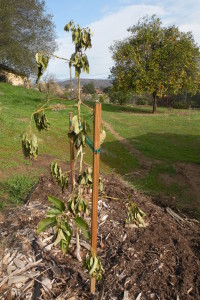
(This was an unusually cold event, when snow fell in parts of southern avocado country: Escondido, Valley Center, and Temecula. See photos of that snow in avocado groves at this blog post by Reuben Hofshi.)
In summary:
–Consider protecting young and small or unhealthy avocado trees when it’s predicted to drop to about 32 degrees
–Consider protecting mature and healthy avocado trees from about 30 degrees
–Don’t anticipate significant damage to mature and healthy avocado trees (fruit and limb damage) until below 27
Preparing an avocado tree for imminent cold: Irrigate
If there’s a weather alert that temperatures will drop below freezing, step one is to be sure your avocado tree is anchored in soil that is moist. Water as necessary. There are two reasons for this: One, an avocado tree in moist soil will be hydrated and best able to handle the stress of low temperatures. Two, moist soil is able to store more heat from the sun during the day, which means it can also radiate that heat at night. (See this interesting article from the University of California, “Passive Frost Protection of Trees and Vines.”)
Remove mulch?
Related to the soil’s ability to store heat and radiate it later, I’ve read advice to remove mulch from beneath the tree since mulch blocks soil from warming as much as possible. This might make sense. I’ve observed the pattern innumerable times in my yard and neighborhood where, during light frosts, mulched (with wood chips or compost) areas are covered by frost while adjacent bare soil is not.
Even so, last winter I experimented with removing mulch from below some of my trees and found unclear results. During the frosty nights of late February 2018, some mulched trees were damaged, some were not. Some unmulched trees were damaged, some were not. I don’t know what conclusions to draw from this, honestly.
Methods of protecting avocado trees from frost and freeze: Overhead coverage
Now for what to do to protect your avocado tree during a frigid night. A small tree is easily protected by putting a roof over its head. Any overhead covering is warmer than nothing.
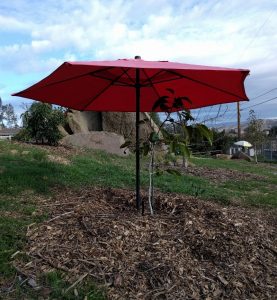
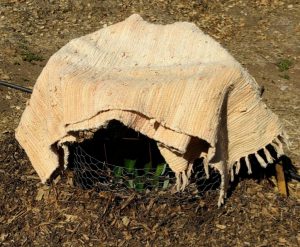
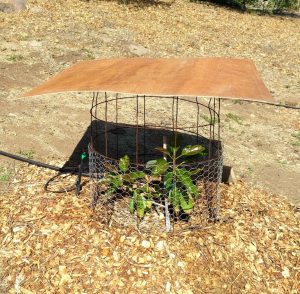
I’ve also used nylon tarps on top of ladders set over the tree, trash cans, cardboard boxes, and more. I’ve seen that they all keep the tree at least a few degrees warmer, in part as judged by the frost forming on ground near such protected trees but not under them, in addition to their sustaining no damage.
How does overhead protection work, and how to use it? The way this method works is by trapping radiation that emanates from both the tree and the soil below the tree. At night, the tree and soil are releasing a certain amount of heat into the air, and if you can block that radiation you can keep the temperature around the tree higher than it otherwise would be.
Higher by how many degrees? I’ve read estimates of 4-8 degrees. It seems to depend on the materials used. Regardless, even if it’s only two degrees higher, a young tree kept at 31 compared to 29 can mean the difference between no damage and all leaves lost.
(See an article from 1951 by Don Gustafson called “Frost Protection of Young Avocado Trees,” showing growers in Orange County using burlap covers.)
Wrapping sides
Will you trap even more heat by wrapping the sides too? Sure thing. It’s like the difference between sleeping under a mere tarp and sleeping in an enclosed tent.
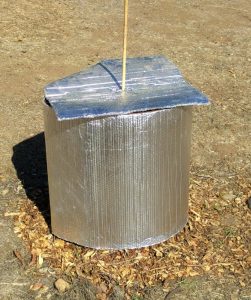
The above photo shows a young avocado tree wrapped in Reflectix bubble insulation. I happen to have some of this material on hand so I’ve used it to protect trees in winters past.
The one thing to keep in mind about using both overhead protection and wrapping the tree entirely is that they should be put in place before sunset to be most effective. You want to begin trapping the radiation before it gets too cold. Also, you want to remove them in the morning once sun is on the tree, unless it’s a structure like my wood board above, which lets light onto the tree and soil. That structure could actually be left in place all winter. (Great option for frost protection if you’re going on vacation.)
Frost blankets
Another material that is deliberately made for insulation, but this time specifically for insulating plants, is a frost blanket such as this one.
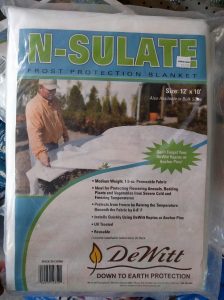
I bought this N-Sulate frost blanket at a nursery for $13. It’s also available online.
Frost blankets can entirely wrap a small tree, and if they do, blankets of this weight (1.5 ounces per square yard) claim to be able to give 6-8 degrees of protection. In my experience, such claims are exaggerated, however. I would only count on about half that amount of protection. (See the videos at the end of this post for more explanation.)
But they can also give somewhat less protection if used to partially cover a larger tree. I’ve got a good crop of fruit on my Lamb avocado tree that I don’t want to lose, so if temperatures threaten to damage this fruit I’ll throw the blanket over it like this.


This frost blanket allows a lot of light to enter, as you can see in the photo above. Because of this, you could safely leave it on a tree during the day. (Another good option for frost protection if you’re going out of town during winter.)
By the way, if you had a couple of smaller avocado trees that you wanted to protect, you could completely wrap them with a pack of smaller frost blankets, such as these 7’x7′ ones made by Agribon, available through Peaceful Valley Farm Supply (Grow Organic.com).
Lights
An additional way to add warmth to a larger tree is the classic Christmas lights approach. Run an extension cord out to the tree, then string Christmas lights (or similar lights) through the tree. Leave the lights on all night, especially through the early morning when it’s usually coldest, to add a few degrees of warming.
Here are some lights that would work for this purpose: Brightown Globe String Lights.
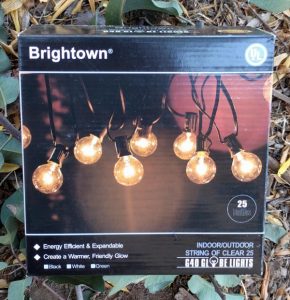

Of course, you can use lights on small trees as well. In fact, both covering a tree and turning lights on under the covering adds maximum heat. You can also use other sources of heat placed below the tree, such as a shop light, a table lamp, or a space heater.
Buckets of water?
Some people claim that you can get some protection by leaving buckets of water under or next to the tree. When water freezes it releases a small amount of heat. I tried this one night a long time ago and found no effect compared to nearby trees that spent the night bucketless. I’m not convinced it is effective, especially compared to other techniques.
Sprinklers?
Taking advantage of this same principle is the idea of running sprinklers under a tree throughout the night. As the water freezes it releases some heat. In order for this to work, the sprinklers must be run continuously all night. I’ve never tried this because other methods seem better suited for a home garden situation. Large groves do make use of this method though. (See this article by Ben Faber of the University of California which briefly notes how to use sprinklers on avocados for frost protection.)
In summary:
–Any overhead coverage raises the temperature around the tree a few degrees.
–Overhead plus side coverage keeps a tree even warmer.
–Lights strung in a tree add warmth.
–Lights or other heat within a covering would add maximum heat and protection of an avocado tree in the cold.
When a winter night gets cruel and it’s below 40 already at dinner time and protecting your avocado tree is called for, is it worth the effort? Yes. I’ve lost young trees in the past that I might be eating from now if only I’d thrown a little protection over them on one or two nights.
Prepare now. Have the materials on hand. This advice is directed at myself as much as anyone, for I’m especially exposed to the cold this winter as I’ve got more small young avocado trees to shepherd than usual. Can we please get a warm and rainy winter like 2016/2017? Wish me luck, I wish you luck.
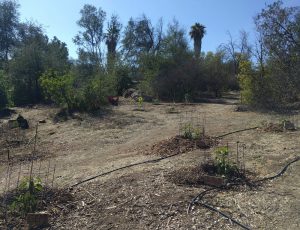
Update March 19, 2019:
The winter certainly was rainy but it was not warm. The coldest night in my yard was February 19 when the thermometer dropped to 27. Fortunately, I didn’t lose even the tiniest of avocado trees.
Mostly, I protected them with frost blankets (Agribon AG-50, as seen here). A few trees I helped with only umbrellas, and for a couple young trees I added heat with lights.
Update February 2020:
A night of 25 degrees caused a spectrum of damage to different trees:
Here is a video of the same trees showing their recovery and the effects of the cold after one year:
Wondering which part of your yard is warmest such that an avocado tree will experience the least winter cold? Check out my post, “Four areas of a yard that are warmer in winter.”
All of my Yard Posts are listed HERE
Growers like you support my Yard Posts, which is why you see no ads. Consider lending your support.

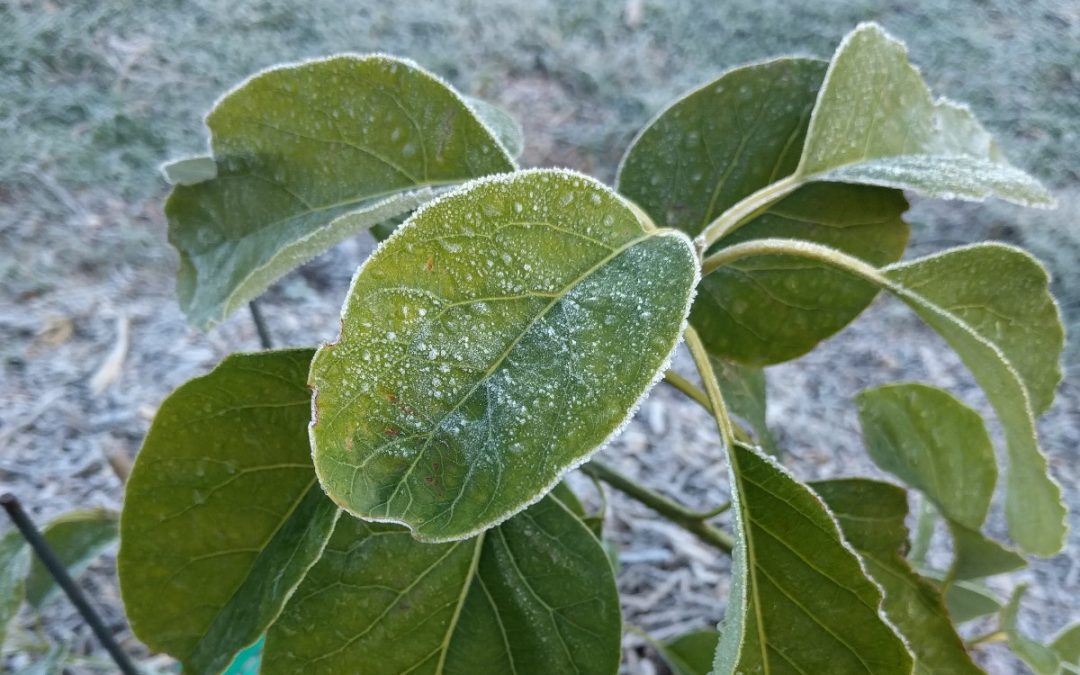


Great article Greg! very thorough. Ill try some of these this winter! Thanks
Thank you Greg for all the information, it was very helpful. I’ll be putting your advice to work.
Hell Greg
You provide such great information which has helped me a great deal! What are your thoughts on good old fashion smudge pots? I had a neighbor give me a few and was thinking of using them this winter if necessary?
Thanks, John! I’ve never used smudge pots myself. They obviously work though. I guess their effectiveness for you might depend on how many you have and how many trees you’re trying to warm with them. My understanding is that each smudge pot only warms a small area. Probably, for the time and money spent, other methods would be more efficient and effective, but then there’s nostalgia . . .
If I had one, I might light it up one frosty night just to see what it felt like to be trying to save a Washington navel orange crop back when Riverside was the citrus capital.
Hi Greg
Thank you for the prompt response! I’m concerned about two trees which I planted this past spring! A five gallon Carmen and a fifteen gallon Sharwil. I’m thinking of placing a smudge pot near each one since they are both so young and vulnerable. My other trees are more mature and seem to have more trouble with the extreme heat than the cold – especially this past July!
So far – I’m proud to be raising the following kids;
2 Reeds, 2 Sharwil, 1 Carmen, 1 Lamb, 1 Sirprize, 1 Pinkerton, 1 Hass, 1 Jan Boyce, 1 Zutano, 1 Fuerte.
I’m really looking forward to growing watermelon and cantaloupe under the canopy as you have suggested! What month would be best to plant the seeds?
Greatly appreciate your posts!
John
Hi John,
What a fantastic avocado portfolio you have growing there. I’ve heard from other inland growers that Carmen only produces one significant crop here. Mine is young like yours, so we’ll see in my yard. Let me know how yours ultimately performs.
This past summer I planted melon seedlings under avocados on June 27, and they performed well. That would mean sowing the seeds in early May. You could certainly safely sow/plant a bit earlier than that too, but mine often get more bug damage if I plant them out much earlier.
I use the wire cage you show in a photo. Only mine is 8’ tall and I make them about 36” to 40” in circumference. I use a clamp light near the base facing upwards to the center of the tree. A 60 watt old style bulb or even a spot light type can give more heat.
Did the Pinkerton survive?
Hi Brandon,
That Pinkerton in the photo above did survive, yes. It grew back fairly well the following summer.
Great advice, thanks for sharing the different options you’ve tried. I’ve not had much of a problem with frost. But I’ll bookmark this post for another day!
Hi Greg,
For frost protection for my five avocado plants that were just planted 7 months ago when they were 3.5 gallons in size, could I get away with clear plastic trash bags? I would put them on before sundown, and remove them the next morning. I’m in Rancho Bernardo, so this would only happen a few times per winter. Amazon sells 25 each of the 96 gallon size for only $25, which is plenty big & much cheaper than any frost blanket I’ve found. Safe enough for a night?
Tom
Hi Tom,
I’m unsure. I’ve never tried this. I imagine the bags would do something but I don’t know how much protection they would offer. You probably only need a couple degrees though, and they could probably provide that if they’re thick enough.
One thing to keep in mind is that wherever the bags touch leaves, the leaves are likely to be burned (if it’s cold enough).
Hey Greg,
Here’s another idea for frost protection….how about one of those blue tarps? I guess they are plastic-based, but do I need to go with something fabric-based to avoid leaf burn?
Tom
Hi Tom,
I get burn where frost blankets touch leaves too if it’s cold enough.
So I settled on building some simple frames out of 1″ x 2″ wood furring strips (Home Depot) and covered them with canvas drop cloths (Harbor Freight). Ready to deploy when frost is forecasted.
A simpler version would be to insert bamboo stakes (Home Depot) into the ground and drape the canvas over them, keeping the weight off the limbs.
I also added some more wood chip mulch, being careful to keep it from contacting the trunks.
Thanks for your guidance, Greg!
Tom
Sounds like good structures, Tom. I was also in the yard today building some structures over young trees for cold protection. I’m designing them to be left in place for a few weeks straight so they need to be a roof that is positioned just high enough to still let sun onto the tree during the day.
I’m also going to experiment this winter with raking away mulch around a few trees to see if it seems to make a difference on cold nights. Mulch does prevent the soil below from absorbing heat during the day, which it radiates at night. I’m interested in seeing whether no mulch appears to make a significant difference in how young trees get through cold nights.
Hey Greg, Have you ever experimented putting those thin reflective solar blankets (the kind first responders use to keep people warm) on the ground under the tree(s) the day before an expected frost, then covering them with a frost blanket/bag?
Maybe enough heat from the sun could be captured inside the frost bag to protect the tree.
I like the idea of lights, but I’m concerned about a fire starting under the frost blanket.
I really like you ideas.
I remember seeing cow dung and horse stables muck out being used to stop hydrocarbon tank 10″ valves from siezing up during -10/20degC winters in Holland. The dung was contained in boxes around these valve at ground level. Dung spread around on the ground about 15″ deep around the trunk + gap would generate a lot of heat for the tree day and night if it is kept moist for fermentation. Adding a plastic sheet wrapped around the perimeter of the dung to direct this heat upwards through the tree might be a bonus.
Well we had some sub-40 degree nights last week in Fallbrook, so I broke out the incandescent x-mas lights from storage and ran them on the 8 young avocado trees. Reminder from my other guest post, I have them hooked up to the internet, my weather station, and IFTTT so they turn on automatically when the temp drops below 40 degrees, even if the forecast wasn’t calling for it.
Besides hopefully preventing any frost damage, they sure look pretty when I turn them all on in the evening. Who says Christmas trees have to be pine? I’m hoping for some presents from my Avocado trees next year 🙂
Hi Dave,
It got down to 35 in my yard and put a little frost on some mulch here and there in low spots. I agree that the lights look great on the trees in the evening!
Hi Greg,
I too live in Ramona and started an avocado grove a year and a half ago. Planted ~200 five gallon avocado trees and will eventually get to over 500 trees. Last night, Jan 25th, we experienced an unusual hail event. I’m sure you experienced it too. The pellets weren’t very large but they created approximately an 1″ sheet of ice on the ground and around the base of the trees and I was curious if you thought young trees would be adversely impacted by this. The temperature of the air didn’t drop below freezing for very long but I’m not sure how ice near the leader/graft would impact the trees. Your insight would be much appreciated.
Warm regards,
Andy
Hi Andy,
Yes, I experienced the same thing. I was up periodically last night checking on trees and monitoring the temperature. Here there was a layer of hail on the ground that didn’t melt starting around 9 PM. I attempted to cover some trees around 11 PM but it was still so windy that I gave up. The temperature was 37 at that time. I awoke just before 4 AM and the temperature had only dropped to 36 although the wind had died. Then just before sunrise the temperature dipped to its low of 31 briefly. The layer of hail only began to melt around 8 AM and is still only partially melted here at 9:30.
I don’t know what the impact of the hail around the trunks of young trees will be. I’ve never experienced this.
I already had thermal wraps around the trunks of all my young trees so that might help. It’s hard to tell what the damage of a cold event is until a couple days or even weeks later. I am seeing mottled leaves already. But I have noticed that young trees can appear fine only to decline and die after some weeks, and it’s then that you realize there was damage to the heart of the trees, the trunk. This has only happened at temperatures far lower than 31 for me, but I don’t know what the impact of the hail/ice will contribute.
What I’m presently worried about is tonight. Since there are no clouds and it’s unlikely to warm up much today, tonight is probably going to get colder than last night. The National Weather Service only predicts 35 for me, but I suspect it will get colder. I’ll be protecting every small tree I can tonight for sure.
If you can, I would wrap the trunks of your trees. Even mounding with mulch will help. At least you’ll be able to save the trunk and graft union so the trees can grow back properly if the leaves get zapped.
I hope I’m actually overreacting though and it does only get down to 35 tonight!
Thanks for the helpful information! I too experienced the hail event down in poway. I’m hoping the 31f temp did not affect my 2 trees (Hass, reed)too bad as the hail was piled up everywhere this morning but I did not see much frost. I am going to get some drop cloths or plastic for tonight and build some type of frame. Should we be able to tell what damage was done, if any, by week 2-3 after the event?
Should we be worried about citrus as well? Many thanks for the guidance.
Hi Paul,
My trees aren’t developing any more signs of damage. I think it just wasn’t cold enough at 31. You certainly shouldn’t have to worry about citrus.
Thanks Greg. I don’t see anything bad either.
I laid old cotton sheets over some 4’ wood stakes I made out of 1”x2”. Hopefully that will provide protection as needed from any frost this season.
Good to know on the citrus.
Thanks Greg for sharing. The article is quite enlightening. I have 200 avo seedlings that I planted last January 2021 in Njombe, Tanzania. As we are approaching cold season in June/July the tips you have shared will be very useful. I will provide updates on how my plants will be faring.
Thank you very much Greg for your prompt and helpful response!
Since I planted the trees, we have had several consecutive unusual weather challenges (frost, record heat, super heavy winds from last week); it has certainly been an adventure.
Would you still recommend wrapping the trees if they are on a slope and have mulch? I still work a full time job and may be a bit time-intensive, but if it will keep them alive, I’ll make the time.
Hi Andy,
I’m currently thinking tonight won’t be as cold as I feared. I’m going to throw some protection over tiny trees, but yours are probably big enough not to need such protection on a night like tonight. It would be so much work at your scale too. My guess is it’s not necessary tonight.
Greg, we live in northeast Texas. We have four 12 foot avocado trees in containers. We just cut them down to 8 foot. They grew in our compost. Two questions-how do we keep them alive in 30 degree weather since they are in containers? Last year it got to 9 and we put them in garage but they doubled in size this year! Also, will they ever produce? They have never bloomed; they are about 3-4 years old.
Hi Maureen,
That’s very cool that you have such big avocado trees there. If you can, just bring them into the garage on nights that are predicted to get below 32 or so. Or at least put them right next to the house, under an eave if possible.
They’ll probably flower eventually. Most seedling avocado trees flower after about seven years, but it varies a lot. Check out this post: https://gregalder.com/yardposts/what-kind-of-avocado-tree-do-you-get-when-you-plant-a-seed/
Anyone ever use a salamander type propane heater to blow warm air under the tree? 4 or 5 dollars of propane would be worth it, if it worked
Hi Steve,
I’ve never tried one of those, but it seems like it could work.
Hey what’s up Greg? Merry Christmas and thanks for all of the info you put out on this website. I live in north Fallbrook in the hills just south of the Riverside county line. We live under a lot of oak trees with a big hill to the east and more oaks to the west that really shorten our days. Anyway, it’s normal for my moms horse water buckets to have ice on them several times throughout the cold season.
For this reason I just gave up on Avos back when we first moved here. After discovering your website and seeing that you pull it off with the same temps in Ramona, I decided to give it another go.
I’m curious if there are avocado rootstocks that are more cold tolerant than others. My Reed and Fuerte trees both look really brown and mottled even though I covered them in plastic during the cold spells we’ve had. They are on G6 I believe, from Maddock nursery.
Yet my Hass tree that is on a Salt tolerant Clonal rootstock from Subtropica is handling it just fine with minimal die back on newer leaves.
My bacon and Mexicola trees are unscathed but were also covered in plastic.
These trees are all very young in the ground for a year or less. So yeah I was just wondering if you’ve noticed differences in how avocado trees handle cold spells based on rootstocks.
Thanks again for all of the info you put out here. It’s a great resource for us home growers.
We moved to FL from PA right in the middle of a cold snap. My partner planted a young avocado tree the summer before so I knew it might be too young to withstand the cold temps FL was having. We placed a ladder over it and draped all sides of the tree with bed sheets. Since we had just driven down from Arctic PA (6 degrees when we left), we had a bunch of hand warmers with us. So, I activated 4 hand warmers and placed 2 at the base of the tree and two rested inside the tree. This worked really well. I don’t know if this method is easy for southerners though because I tend to doubt hand warmers are easy to come by in the south, LOL.
Awesome report! Thanks, Adriane. No, I don’t know anyone around here who has hand warmers to use, but it’s fun to know that they work. Best of luck with your avocado tree.
Hello! I love that you share your knowledge with others so freely!
I hope that you can help me in my situation. I garden in 7 gallon containers and smaller, over a concrete slab.
My area is generally windy and colder during the year. During summer in August and September we can get some heat. The slab is generally cold and I want to protect my fruit trees during the cold from 30° to 60°. Sometimes colder sometimes warmer.
Would putting emergency blankets under the pots on an on-going basis help?
I can’t build anything to set the pots on.
I know that this is not the best set-up to grow fruit trees but it is all I have!
Thank you for any help and suggestions that you ir your readers might have!
Hi Bobbie,
Are you worried about the roots getting too cold? Are these just avocados you’re worried about?
Hi Greg!
Yes I am w I rried about the roots getting cold, but also the tree itself.
Would emergency type blankets underneath pots as well as around the fruit trees themselves be the best way to help the trees survive and without damage?
Would the emergency type blankets be able to reflect back the sun’s rays to provide better growth all year long?
Where the trees are in San Francisco, it can be cold and windy.
This is for avocados, citrus, bananas, figs, cherries, apples, and Dragon fruit.
Thank you!
Instead of incandescent lights (which my neighbors may not love), what do you think of soil warmers? They could be placed on the ground or wrapped into the tree to provide heat. Maybe more efficient heat at that. I was looking at something like this now that Winter is Coming…
https://charleysgh.com/products/economy-heat-cable
Hi Dan,
Why have I never heard of anyone doing this? It seems like it would work, especially if the canopy is wrapped or roofed to trap the rising heat.
What are the drawbacks of sawdust or wood shavings around the base of the avocado trunk? My neighbor and I are always trying new ways to counter Jack Frost.
She wants to place 4-5″ mounds around each trunk and leave them until spring before removing, and is also using the standard nursery 1.2 oz. bag supported over the main part of the plant. Sacramento gets some chilly nights, right now around 33-34 degrees, but last year we managed 24-26 for a couple of nights. I used only sheets and supports but my eight trees barely made it. Who said farming was easy, ? LOL.
Hi William,
Piling stuff around the trunk will protect the trunk from cold damage. You can use lots of materials for this, even dirt or corn stalks. But that won’t protect the rest of the tree. Cold can still damage the entire rest of the canopy.
Sheets can help a little bit, but something thicker will give more protection. I find that even a thick, wide umbrella gives more protection than a sheet despite the umbrella not enclosing the sides of the tree.
Good luck this winter! It seems to be starting out chilly up in the Sacramento area and down south, but hopefully it doesn’t dip too low.
Hey Greg,
Thanks for the great information here! I’m in Fallbrook, and one of my mature avocados is already full of flower buds. It did the same last year, and most of the flowers ended up falling off, which I’m guessing is because it flowered too early, not sure. Any advice here? Will covering it if it gets too cold help?
When I painted the trunk and sprayed the branches with the diluted latex paint to protect the avocado tree from the heat wave, will the paint that are still on the tree also give some protect ion from the cold also?
Hi Laura,
I don’t think so. I’ve never seen painted trunks at my place do better in cold.
Thank you so very much. All your information has been very helpful to me. I’m just beginning growing little avocado tree.
We get a lot of rain up here in north coastal California. My avocado trees are in raised mounds or raised beds. In the rainy season November through April/May, I cover them in a sheet of thick black plastic to protect from too much rain, plus I like to think it helps keep the roots a bit warmer, plus it cuts down on the weeds. This past winter we actually a little snow on the ground (rare hear) and I thought i has lost the 5 year old Hass. But by early June it had recovered nicely. Today it’s bushy with lots of new shoots changing into limbs. Fingers crossed this coming winter is a bit tamer and the Hass and the others are a little stronger.
I have an avocado tree that I started from an avocado pit about 3 years ago. It was just a “for fun”project that I started with my grandkids. I did not take it too seriously, initially. Now the tree is about 3 feet tall. With the encouragement of my grandkids, I have taken a vested interest in keeping it thriving. It does great in south Louisiana in the spring thru fall months, in a selected area in my yard. But, the winter months are a bit more touchy. It is still in a large pot. So, I am able to bring it in, when the weather gets too cold. However, I will need to put it in the ground eventually. Thank you for the great information that you have shared. It is very helpful. Have a great day.
Hi, Greg,
I have a young Pinkerton (2-3 years) whose main stalk suffered frost damage, blackened, and died down to its base last winter. Since then, a different branch has grown straight up and looks as if it’s the “new” stalk. The tree looks overall happy and healthy.
Would you happen to know whether this tree will still flower and grow? My local nursery believes that it won’t, so I’m uncertain whether I should pull it out of the ground and replace it. Thank you.
Hey Greg,
I live in the northern part of the Sacramento Valley of California. My Hass Avocado tree is 4 years old and still only 4′ tall. It has froze every winter, covered or not, light for warmth or not. the first summer the direct sun burnt it up. We just had a week of cold temps, the lowest I saw was 32 degrees, tree is wrapped, light on at night, I just went out and checked it, all the new growth is froze to a crisp…I think I am going to give up. Hass Avocado are not ment for this far north!
I think my 3yr old avocado grown from seed sustained frost damage. North side got blackened. Leaves look ok.
Should I do anything different?
Hi Elaine,
North side of what got damaged? Leaves on the north side of the canopy? That’s what usually happens in light frost, as well as some top damage. Sounds like your tree has no significant damage so no worries.
What if the leaves are wilting but there’s moisture
Hi Greg,
Thank you for sharing all of your knowledge and experience!
I was thinking about Chicago Hardy fig; only the roots are actually hardy, so mine dies back significantly every winter, but the branches will fruit on the newly sprouted branches so it still works in cold climates (at least some years).
I know it’s unlikely, but have you heard of any avocado that fruits on first year branches?
Hi Ari,
I don’t know of any avocado variety that blooms on first year branches. The most precocious varieties I know will bloom on branches that grew the previous spring/summer/fall. So you have to get those branches through a winter safely.